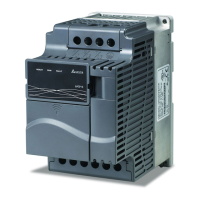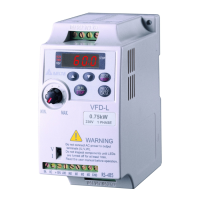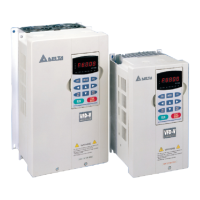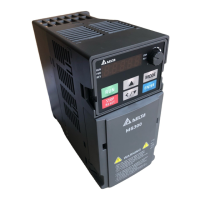Chapter 16 PLC Function ApplicationsMS300 (High Speed Model)
16-15
The various internal devices in a PLC all account for a certain quantity of storage units in the
PLC's storage area. When these devices are used, the content of the corresponding storage area is
red in the form of bits, bytes, or words.
Introduction to the basic internal devices in a PLC
Device
type
Description of Function
Input
Relay
An input relay constitutes the basic unit of storage in a PLC's internal memory
corresponding to an external input point (which serves as a terminal connecting with an
external input switch and receiving external input signals). It is driven by external input
signals, to which it assigns values of 0 or 1. A program design method cannot change
the input relay status, and therefore cannot rewrite the corresponding basic units of an
input relay, and WPLSoft cannot be used to perform compulsory On/Off actions. A
relay's contacts (contacts a and b) can be used an unlimited number of times. An input
relay with no input signal must be left idle and cannot be used for some other purpose.
Device indicated as: X0, X1, X7, X10, X11, etc. This device is expressed with the
symbol "X," and a device's order is indicated with an octal number. Input point
numbers are indicated in the main computer and in expansion devices.
Output
Relay
An output relay constitutes the basic unit of storage in a PLC's internal memory
corresponding to an external output point (which connects with an external load). It may
be driven by an input relay contact, a contact on another internal device, or its own
contacts. It uses one NO contact to connect with external loads or other contacts, and,
like input contacts, can use the contact an unlimited number of times. An output relay
with no input signal will be idle, but may be used an internal relay if needed.
Device indicated as: Y0, Y1, Y7, Y10, Y11, etc. This device is expressed with the
symbol "Y," and a device's order is indicated with an octal number. Output point
numbers are indicated in the main computer and in expansion devices.
Internal
Relay
Internal relays have no direct connection with the outside. These relays are auxiliary
relays inside a PLC. Their function is the same as that of an auxiliary (central) relay in an
electrical control circuit: Each auxiliary relay corresponding to a basic unit of internal
storage; they can be driven by input relay contacts, output relay contacts, and the
contacts of other internal devices. An internal auxiliary relay's contact can also be used
an unlimited number of times. Internal relays have no outputs to outside, and must
output via an output point.
Device indicated as: M0, M1 to M799, etc. This device is expressed as the symbol
"M," expressed, and its order is expressed as a decimal number.
Counter
A counter is used to perform counting operations. A count setting value (such as the
number of pulses to be counted) must be assigned when a counter is used. A counter
contains a coil, contact, and a counting storage device. When the coil goes from Off to
On, this indicates that the counter has an input pulse, and one is added to its count.
There are 16 bits that can be employed by the user.
Device indicated as: C0, C1 to C79, etc. This device is expressed as the symbol "C,"
expressed, and its order is expressed as a decimal number.
Timer
A timer is used to complete control of timing. The timer contains a coil, contact, and a
time value register. When the coil is electrified, if the preset time is reached, the contact
will be actuated (contact a will close, contact b will open), and the timer's fixed value be
given by the set value. Timer has a regulated clock cycle (timing units: 100 ms). As soon
as power to the coil is cut off, the contact will no longer be actuated (contact a will open,
contact b will close), and the original timing value will return to zero.
Device indicated as: T0, T1 to T159, etc. The device is expressed as the symbol "T,"
and its order is expressed as a decimal number.
Data
register
When a PLC is used to perform various types of sequence control and set time value
and count value control, it most commonly perform data processing and numerical
operations, and data registers are used exclusively for storage of data and various
parameters. Each data register contains 16 bits of binary data, which means that it can
store one word. Two data registers with adjacent numbers can be used to process
double words.
Device indicated as: D0, D1 to D399, etc. The device is expressed as the symbol
"D," and its order is expressed as a decimal number.

